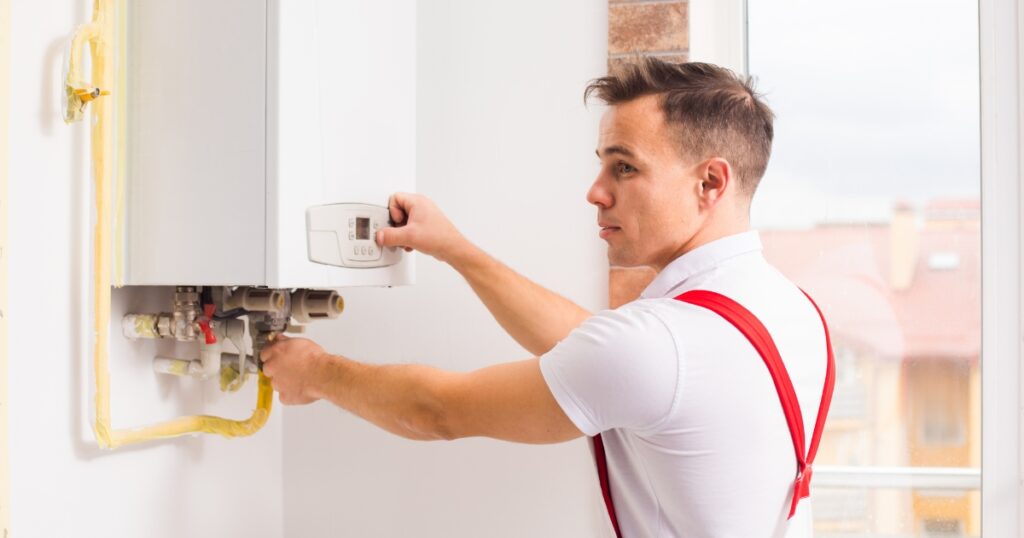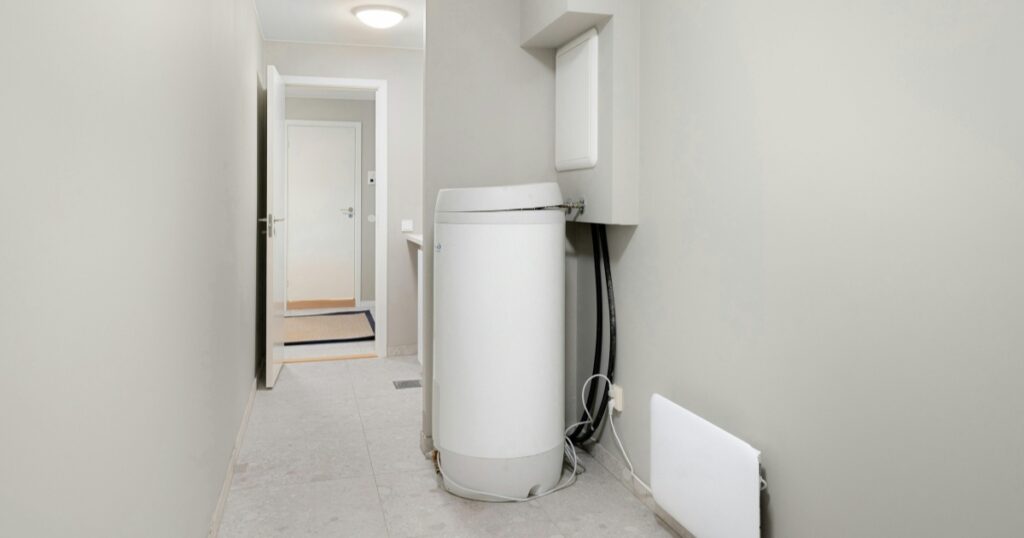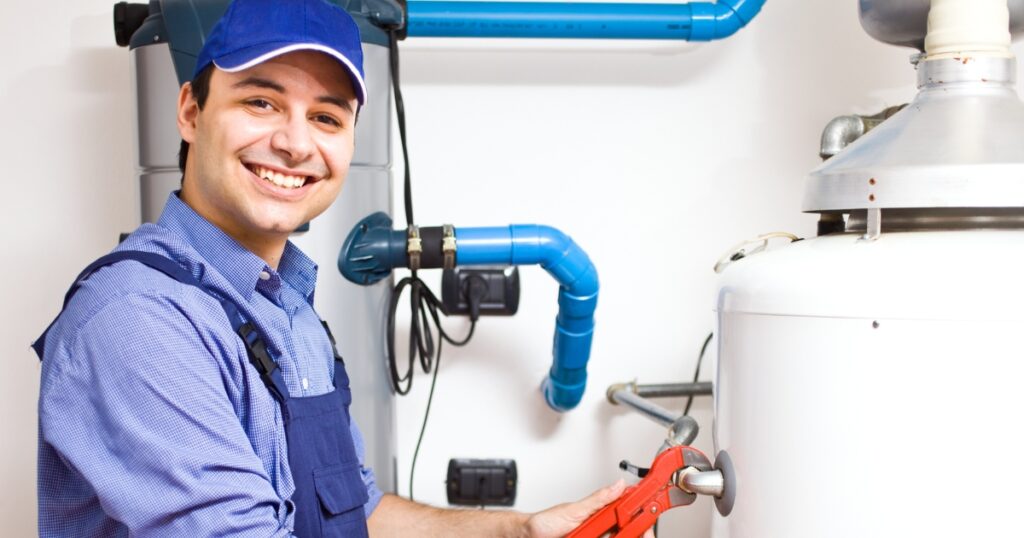Ever had that cheeky moment when your hot water turns lukewarm, or it’s coming out looking a bit dodgy? You’re definitely not the only one scratching their head over this. More often than not, there’s a tiny yet gutsy warrior to thank for keeping things in check: the anode rod.
This unsung hero is hard at work inside your hot water system, guarding it against the dreaded rust and corrosion like a good mate on watch.
Our yarn today spins around these anode rods, shedding light on why they’re so critical and how you can keep ’em in top nick for that blissful, steaming hot shower we all reckon is pure gold.
So stick with us – it’s simpler than figuring out the footy finals ladder!
Key Takeaways
- Anode rods are crucial components in a hot water heater, actively preventing corrosion and rusting by sacrificing themselves to protect the tank.
- Regular inspection and replacement of anode rods every 3 – 4 years extend the lifespan of your water heater, ensuring safe, clean hot water for household needs.
- Annual inspections, checking for visible corrosion or low pH levels in the water, will indicate when it’s time to replace the anode rod.
- Flushing and draining the water heater regularly helps remove sediment buildup inside the tank, ensuring efficient operation.
What is a Water Heater Anode Rod?
The water heater anode rod is a crucial component that helps prevent corrosion and rusting in the tank. There are different types of anode rods, including aluminium, magnesium, zinc-aluminium alloy, and powered rods.

Types of anode rods (aluminium, magnesium, zinc-aluminium alloy, powered)
As homeowners, we need to keep our hot water heaters in top shape. One way to do this is by understanding the different types of anode rods that protect our tanks from corrosion.
- Aluminium Anode Rods: These rods are popular due to their affordability and reliability in hard water areas. Aluminium anodes are known for their durability, but they can sometimes create an aluminium oxide build-up at the bottom of the tank which requires regular flushing.
- Magnesium Anode Rods: Preferred for their efficiency in softer water, magnesium anode rods offer superior corrosion protection. They tend to be more reactive than aluminium, sacrificing themselves quicker and thus may require more frequent replacement.
- Zinc-Aluminium Alloy Anode Rods: Incorporating zinc with aluminium can help reduce sulphur smells from the water that results from specific bacteria. This type of rod combines durability and odour prevention, making it a thoughtful choice for homes with “smelly” water issues.
- Powered Anode Rods: Unlike traditional sacrificial rods, powered anodes use electrical currents to prevent corrosion without getting consumed over time. They’re ideal for households with softened water or those looking for a long-lasting solution to rust prevention.
Role of Anode rods in preventing corrosion and Rusting
Transitioning from understanding the different types of anode rods to their essential role in preventing corrosion and rusting, it’s crucial for homeowners to grasp the significance of this component.
Anode rods play a pivotal role in protecting your water heater tank from corrosion and rust buildup by Sacrificial protection. The sacrificial anode rod is made of magnesium or aluminium and extends through the water heater tank.
This sacrificial nature means that the anode rod corrodes over time, sparing your water heater tank from deterioration.
Replacing the hot water tank’s anode rod every 3-4 years helps maintain optimal performance and prolongs the lifespan of your water heating system. By regularly inspecting and replacing these rods as needed, you can ensure clean, safe water while controlling tank corrosion effectively.
Why are Anode Rods Important?
Anode rods are crucial for preventing corrosion and rusting inside the water heater tank. They help extend the lifespan of the water heater, ensuring that you have safe and clean water for your household needs.
Protecting the water heater tank
The water heater anode rod plays a crucial role in protecting the tank from corrosion and rusting. By attracting corrosive elements, the sacrificial anode rod prevents these substances from attacking the inner lining of the tank, thereby extending its lifespan.
The anode rod safeguards the water heater tank by sacrificing itself to prevent corrosion, ensuring that your hot water remains clean and safe for use.
Regular inspection and replacement of the anode rod are essential maintenance tasks to uphold the effective protection of your water heating system’s tank against corrosion.
Extending the lifespan of the heater
Extending the lifespan of your water heater is crucial for ensuring long-term efficiency and reliability. Regular inspection and replacement of the anode rod every 3-4 years can significantly prolong the life of your hot water tank, protecting it from corrosion and rusting.
By maintaining a clean and well-functioning anode rod, you can prevent damage to the interior lining of the tank, ultimately saving on costly repairs or premature replacements.
Furthermore, keeping up with routine maintenance tasks such as flushing and draining the water heater will help maintain optimal performance while preserving the quality of your hot water supply.
Ensuring safe and clean water
To ensure safe and clean water, it is crucial to understand the role of anode rods in preventing tank corrosion and rusting. Through routine inspection and replacement of the sacrificial anode every 3-4 years, you can protect your water heater tank from deterioration, ultimately safeguarding the quality of the hot water supply.
The anode rod acts as a barrier against contaminants by attracting corrosive elements that would otherwise affect the water heater. By staying proactive in maintaining this essential component, you not only extend your system’s lifespan but also promote healthier and cleaner hot water for everyday use.
Regular maintenance of the anode rod directly impacts the cleanliness and safety of the water running through your plumbing fixtures. This simple yet critical step ensures that your family has access to high-quality hot water while reducing potential risks associated with corroded tanks or contaminated supplies.

How Often Should You Check and Replace the Anode Rod?
We’ll discuss the recommended frequency of inspecting anode rods, potential signs that indicate the need for replacement, and how to determine if it’s time for a new anode rod.
Recommended frequency of inspection (annually)
When maintaining your hot water heater, it is vital to inspect the anode rod annually. This simple task can help prevent corrosion and prolong the lifespan of your water heater. Regular inspections ensure that any signs of excessive wear or corrosion on the anode rod are detected early, allowing for timely replacement.
By following this recommended frequency of inspection, you can safeguard your water heater and maintain a safe and efficient hot water supply for your home.
Inspecting the anode rod annually is key to sustaining your water heater’s performance and protecting it from corrosion. Consider marking this task on your calendar as part of routine home maintenance to ensure clean and safe hot water for daily use.
Signs that the anode rod needs to be replaced (corrosion, low pH levels)
We can tell that the anode rod needs replacement if we observe corrosion on the rod. This typically shows visible deterioration and flaking of the rod material. Additionally, low pH levels in the water can also indicate that the anode rod needs replacing, as this means it has likely reached the end of its lifespan.
- Visible corrosion on the anode rod, such as flaking or deterioration of material, indicates that it needs to be replaced.
- Low pH levels in the water suggest that the anode rod has likely worn out and should be replaced to maintain the proper functioning of the water heater.
Steps for Checking and Replacing Anode Rods
First, flush and drain the water heater to remove any sediment or build-up. Next, test the water quality to ensure it is safe and clean for use. Then, choose the right replacement anode rod based on the type of water heater you have. Finally, carefully replace the old anode rod with the new one to maintain your hot water heater’s efficiency and lifespan.
Flushing and draining the water heater
To maintain our hot water tank, we need to regularly flush and drain the water heater. This will help remove sediment and mineral buildup inside the tank, ensuring its efficient operation. Here’s a step-by-step guide for flushing and draining your water heater:
- First, turn off the power supply to the water heater. For electric heaters, switch off the circuit breaker, and for gas heaters, set the control knob to “pilot.”
- Next, locate the cold water inlet valve at the top of the heater and turn it off to stop incoming water.
- Connect a garden hose to the drain valve located at the bottom of the tank. Ensure that the other end of the hose is placed in an area where it’s safe to discharge hot water.
- Open a hot water faucet in your home to allow air into the system and help with draining.
- Now, slowly open the drain valve on your water heater and let all of its contents empty into a floor drain or outside. Be cautious as this water will be very hot.
- Once all of the water has drained out completely, close both valves (the drain valve and cold water inlet valve).
- Finally, carefully open up your cold-water inlet valve again to fill up your tank once more.
Testing water quality
After flushing and draining the water heater, it’s important to assess the quality of the water. This step ensures that your hot water remains safe and clean for use. Here’s what you need to do:
- Check for any discolouration or unusual odours in the hot water, as these can indicate potential issues with the water quality.
- Test the pH levels of the hot water using a simple testing kit available at hardware stores or online. Low pH levels can accelerate corrosion in your water heater tank.
- Determine if there are any sediments or particles present in the hot water by filling a clear container and examining it closely.
- Consider having your water tested by a professional if you notice any irregularities, as this can provide more accurate insights into the overall quality and safety of your hot water supply.
- Keep an eye out for any changes in taste or texture of the hot water, as these can also be indicators of compromised water quality.
- If you have concerns about the quality of your hot water, consider installing additional filtration systems or contacting a professional plumber to address any underlying issues.
Choosing the right replacement anode rod
When selecting a replacement anode rod, consider the type of metal – aluminium, magnesium, zinc-aluminium alloy, or power – based on your water’s pH levels and the prevailing water quality.
- Aluminium anode rods are suitable for areas with hard water as they are more resistant to mineral build-up.
- Magnesium anodes are ideal for areas with soft water and are effective in preventing corrosion caused by acidic water.
- Zinc-aluminium alloy anode rods offer combined protection and work well in diverse water conditions.
- Powered anode rods use electrical currents to prevent corrosion and are designed for those wanting a maintenance-free option.
Replacing the anode rod
Choosing the right replacement anode rod is crucial to ensure the effectiveness of your water heater. When considering replacing the anode rod, follow these steps for a smooth process:
- Begin by turning off the power supply and shutting off the cold-water inlet to the heater.
- Drain a few gallons of water from the tank to reduce pressure before accessing and removing the old anode rod.
- Use a suitable wrench to carefully loosen and remove the existing anode rod from its location in the water heater tank.
- Ensure thorough cleaning of any sediment or debris around the opening where the old rod was located.
- Install and secure the new anode rod in place using Teflon tape on its threads to prevent leaks.
- Refill the water heater tank, open all hot water faucets, and allow air to escape from the system before restoring power to your water heater.
Maintaining Anode Rods
Flush and drain the water heater regularly to keep the anode rod in good condition. Other related maintenance tips include checking for leaks, adjusting the temperature, and inspecting the pressure relief valve.
Flushing and draining the water heater regularly
To maintain the water heater, it is important to flush and drain it regularly. Here are the steps to follow:
- Turn off the water heater and let it cool down before draining.
- Shut off the cold water supply valve to the water heater.
- Connect a garden hose to the drain valve at the bottom of the tank.
- Open a hot water faucet in your house to allow air into the system so the tank can drain smoothly.
- Open the drain valve and allow the tank to completely empty.
- After draining, close all valves and remove the hose.
Other related maintenance tips
To keep your hot water heater running efficiently and extend its lifespan, it is essential to perform regular maintenance. Here are some related maintenance tips for maintaining your water heater:
- Check the temperature and pressure relief valve annually.
- Insulate the hot water pipes to reduce heat loss and increase energy efficiency.
- Clean the sediment buildup in the tank at least once a year.
- Ensure that the heating element or gas burner is free from debris and functioning properly.
- Test the water heater’s pressure to ensure it falls within the recommended range.
Know More about Hot Water Heater Anode Rods
In conclusion, understanding the significance of hot water heater anode rods is essential for maintaining a durable and efficient system. Regular inspection and replacement of anode rods play a crucial role in preventing tank corrosion and ensuring clean water.
By following the recommended maintenance steps, homeowners can extend the lifespan of their water heaters and guarantee safe, high-quality hot water for everyday use.






